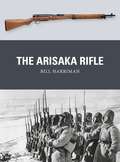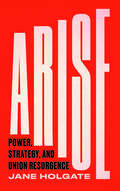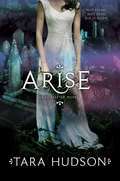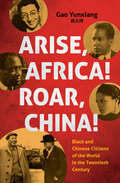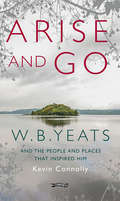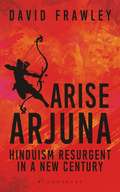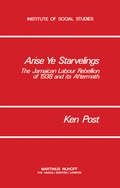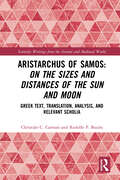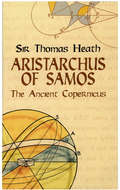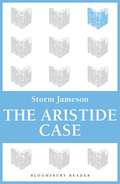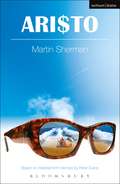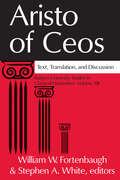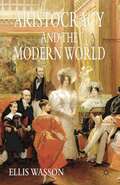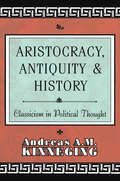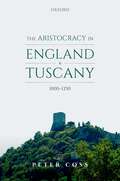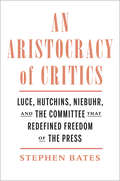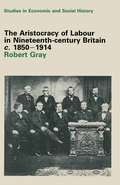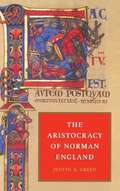- Table View
- List View
The Arisaka Rifle (Weapon #70)
by Bill HarrimanEntering service in 1897, the Arisaka family of bolt-action rifles armed Japanese troops and others through two world wars and many other conflicts, including the Russo-Japanese War of 1904–05. Issued in long and short versions – the latter for cavalry and specialists – the Type 30 was the first main Arisaka model, arming Imperial Japan's forces during the Russo-Japanese War, though after the war it was refined into the Type 38, which would still be in use in 1945. The main Arisaka rifle of World War II though was the Type 99. Lighter and more rugged than the US M1903 Springfield rifle it would face in the initial battles in the Pacific, it was produced in four main variants, including a sniping model and a take-down parachutist's rifle. Featuring full-colour artwork as well as archive and close-up photographs, this is the absorbing story of the rifles arming Imperial Japan's forces, from the trenches of Mukden in 1905 to the beaches of Okinawa 40 years later.
Arise: The Art of Transformational Coaching
by Elena AguilarA hands-on guide for transformational coaches working in school environments In Arise: The Art of Transformational Coaching, renowned author and coach Elena Aguilar delivers a compelling and inspirational message about how to coach in the face of daunting challenges. In the book, you’ll learn how to listen expansively in a coaching conversation, how to plan conversations effectively, how to coach across lines of racial difference, how to coach resistant teachers, and more. You’ll learn how best to impact your clients’ “3 B’s”: beliefs, behaviors, and ways of being and explore illuminating case studies that highlight and illustrate the concepts discussed in the book. You’ll also find: A Transformational Coaching Rubric 2.0 providing detailed explanations of all relevant coaching domains and indicators Comprehensive discussions of the reasoning and theory underlying the practical strategies explained within Techniques for developing, maintaining, and applying emotional intelligence in your work An indispensable “how-to” guide for transformational coaches working in school environments, Arise: The Art of Transformational Coaching is the hands-on and practical roadmap to results that professionals in this area have been waiting for.
Arise: The Art of Transformational Coaching
by Elena AguilarA hands-on guide for transformational coaches working in school environments In Arise: The Art of Transformational Coaching, renowned author and coach Elena Aguilar delivers a compelling and inspirational message about how to coach in the face of daunting challenges. In the book, you’ll learn how to listen expansively in a coaching conversation, how to plan conversations effectively, how to coach across lines of racial difference, how to coach resistant teachers, and more. You’ll learn how best to impact your clients’ “3 B’s”: beliefs, behaviors, and ways of being and explore illuminating case studies that highlight and illustrate the concepts discussed in the book. You’ll also find: A Transformational Coaching Rubric 2.0 providing detailed explanations of all relevant coaching domains and indicators Comprehensive discussions of the reasoning and theory underlying the practical strategies explained within Techniques for developing, maintaining, and applying emotional intelligence in your work An indispensable “how-to” guide for transformational coaches working in school environments, Arise: The Art of Transformational Coaching is the hands-on and practical roadmap to results that professionals in this area have been waiting for.
Arise: Power, Strategy and Union Resurgence (Wildcat)
by Jane Holgate'Jane Holgate is a brilliant thinker' - Jane McAlevey In Arise, Jane Holgate argues that unions must revisit their understanding of power in order to regain influence and confront capital. Drawing on two decades of research and organising experience, Holgate examines the structural inertia of today’s unions from a range of perspectives: from strategic choice, leadership and union democracy to politics, tactics and the agency afforded to rank-and-file members. In the midst of a neoliberal era of economic crisis and political upheaval, the labour movement stands at a crossroads. Union membership is on the rise, but the ‘turn to organising’ has largely failed to translate into meaningful gains for workers. There is considerable discussion about the lack of collectivism among workers due to casualisation, gig work and precarity, yet these conditions were standard in the UK when workers built the foundations of the 19th-century trade union movement. Drawing on history and case studies of unions developing and using power effectively, this book offers strategies for moving beyond the pessimism that prevails in much of today’s union movement. By placing power analysis back at the heart of workers' struggle, Holgate shows us that transformational change is not only possible, but within reach.
Arise: Power, Strategy and Union Resurgence (Wildcat)
by Jane Holgate'Jane Holgate is a brilliant thinker' - Jane McAlevey In Arise, Jane Holgate argues that unions must revisit their understanding of power in order to regain influence and confront capital. Drawing on two decades of research and organising experience, Holgate examines the structural inertia of today’s unions from a range of perspectives: from strategic choice, leadership and union democracy to politics, tactics and the agency afforded to rank-and-file members. In the midst of a neoliberal era of economic crisis and political upheaval, the labour movement stands at a crossroads. Union membership is on the rise, but the ‘turn to organising’ has largely failed to translate into meaningful gains for workers. There is considerable discussion about the lack of collectivism among workers due to casualisation, gig work and precarity, yet these conditions were standard in the UK when workers built the foundations of the 19th-century trade union movement. Drawing on history and case studies of unions developing and using power effectively, this book offers strategies for moving beyond the pessimism that prevails in much of today’s union movement. By placing power analysis back at the heart of workers' struggle, Holgate shows us that transformational change is not only possible, but within reach.
Arise (Hereafter Trilogy Ser. #2)
by Tara HudsonA stranded spirit, and a love story that crosses the divide between the living and the dead…
Arise Africa, Roar China: Black and Chinese Citizens of the World in the Twentieth Century (The John Hope Franklin Series in African American History and Culture)
by Yunxiang GaoThis book explores the close relationships between three of the most famous twentieth-century African Americans, W. E. B. Du Bois, Paul Robeson, and Langston Hughes, and their little-known Chinese allies during World War II and the Cold War—journalist, musician, and Christian activist Liu Liangmo, and Sino-Caribbean dancer-choreographer Sylvia Si-lan Chen. Charting a new path in the study of Sino-American relations, Gao Yunxiang foregrounds African Americans, combining the study of Black internationalism and the experiences of Chinese Americans with a transpacific narrative and an understanding of the global remaking of China's modern popular culture and politics. Gao reveals earlier and more widespread interactions between Chinese and African American leftists than accounts of the familiar alliance between the Black radicals and the Maoist Chinese would have us believe. The book's multilingual approach draws from massive yet rarely used archival streams in China and in Chinatowns and elsewhere in the United States. These materials allow Gao to retell the well-known stories of Du Bois, Robeson, and Hughes alongside the sagas of Liu and Chen in a work that will transform and redefine Afro-Asia studies.
Arise And Go: W.B. Yeats and the people and places that inspired him
by Kevin ConnollyThe idea of place runs like a river through the life and works of the poet and playwright W.B. Yeats. This book focuses on his time in Dublin, London, Sligo and elsewhere in the west of Ireland, embracing the homes, landscapes and people that impacted his life and stimulated his vast body of work. Meet the poet’s father, the struggling artist John Butler Yeats; his mother Susan, the well-to-do Sligo girl who had no choice but to follow her husband’s path; his five siblings: Lily and Lolly, guiding lights in the Irish Arts and Crafts movement; Jack, the renowned painter; and Bobbie and Jane Grace, who died in infancy. Meet William Morris, John O’Leary, Katharine Tynan, George Moore, Oscar Wilde, Lady Gregory, Douglas Hyde, George Hyde-Lees, and, of course, Maud Gonne, as well as countless others who helped weave the cloth of Yeats’s poetic gift.
Arise Arjuna: Hinduism Resurgent in a New Century
by David FrawleyIndia faces a modern Kurukshetra as the forces of dharma and adharma clash again in a conflict that will determine the future of the nation. On one side are the forces of economic growth, cultural revival and a renewed vision of the country in harmony with its yogic values. On the other side are forces of religious prejudices, baseless propaganda, social division and materialistic political ideologies.Mere retreat, passivity or compromise cannot overcome past adversaries or the new dangers that are lurking in our conflicted media age, its invasive technology and the disruptive clash of cultures. India needs to benefit from the opportunities of the dawning knowledge era where its dharmic traditions can prosper once again. A new spiritual warrior, equipped with yogic power and Vedantic insights, is necessary like Arjuna was under the guidance of Sri Krishna. This book is a call for new Arjunas to emerge among us, learn the skills of the information age and uphold the cause of dharma with discernment and dedication on both intellectual and spiritual levels.Only through this can we awaken our spirit to uplift our world at this critical juncture of human history when the very foundations of life are threatened.
Arise Ye Starvelings: The Jamaican Labour Rebellion of 1938 and its Aftermath (Institute of Social Studies Series on Development of Societies #3)
by K. PostAristarchus of Samos: Greek Text, Translation, Analysis, and Relevant Scholia (Scientific Writings from the Ancient and Medieval World)
by Christián C. Carman Rodolfo P. BuzónThis book offers the Greek text and an English translation of Aristarchus of Samos’s On the Sizes and Distances of the Sun and Moon, accompanied by a full introduction, detailed commentary, and relevant scholia. Aristarchus of Samos was active in the third century BC. He was one of the first Greek astronomers to apply geometry to the solution of astronomical problems as we can see in his only extant text, On the Sizes and Distances of the Sun and Moon. Alongside the Greek text and new English translation, the book offers readers the Latin text and English translation of Commandino’s notes on the text. Readers will also benefit from a comprehensive introductory study explaining the value of Aristarchus’s calculations and methodology throughout history, as well as detailed analyses of each part of the treatise. This volume will be of interest to students and scholars working on ancient science and astronomy and the general reader interested in the history of science.
Aristarchus of Samos: The Ancient Copernicus
by Thomas Heath"A most welcome addition to the literature of astronomical history." -- Nature"A most important contribution to the early history of Greek thought and a notable monument of English scholarship." -- Journal of Hellenic StudiesThis classic work traces Aristarchus of Samos's anticipation by two millennia of Copernicus's revolutionary theory of the orbital motion of the earth. Heath's history of astronomy ranges from Homer and Hesiod to Aristarchus and includes quotes from numerous thinkers, compilers, and scholasticists from Thales and Anaximander through Pythagoras, Plato, Aristotle, and Heraclides. 34 figures.
The Aristide Case
by Storm JamesonAristide Michal's wife Lotte is not his wife, nor is his son Philippe his son. He is deeply attached to both, and to the modest little Hotel Moderne Aristide he is running in a village in the hills behind Nice and Cannes, with its admirable small restaurant, and its faithful café circle which includes an old Englishman with his own reasons for anger and pity. What happens to Michal himself, to Lotte and Philippe, to the old Englishman, and to the boy Jean in the months before he comes to accept his divided loyalty, forms plot and theme of a work of imagination told with consummate narrative skills.
Aristo (Modern Plays)
by Martin ShermanAristo is the new play by Martin Sherman that has its world premiere at the Chichester Festival from 11 September - 11 October prior to a West End transfer. It will star Robert Lindsay and Diana Quick. Based on the last years of the life of the wealthy shipping magnate Aristotle Onassis who after a notorious affair with Maria Calas married Jacqueline Kennedy, widow of US President John F. Kennedy, in 1968. The play explores his complex interwoven relationships with Calla, Kennedy and his son by Callas, Alexandros, who died in a plane crash in 1973. Based in part on Peter Evans' book Nemesis, Aristo is an explosive account of how those in positions of enormous power and wealth often live lives detached from the realities and moral codes of everyday existence. The play will not be a programme text.
Aristo (Modern Plays)
by Martin ShermanAristo is the new play by Martin Sherman that has its world premiere at the Chichester Festival Theatre from 11 September - 11 October prior to a West End transfer. It will star Robert Lindsay and Diana Quick.Based on the last years of the life of the wealthy shipping magnate Aristotle Onassis who after a notorious affair with Maria Calas married Jacqueline Kennedy, widow of US President John F. Kennedy, in 1968. The play explores his complex interwoven relationships with Calla, Kennedy and his son by Callas, Alexandros, who died in a plane crash in 1973.Based in part on Peter Evans' book Nemesis, Aristo is an explosive account of how those in positions of enormous power and wealth often live lives detached from the realities and moral codes of everyday existence.
Aristo of Ceos: Text, Translation, and Discussion (Rutgers University Studies in Classical Humanities)
by William Fortenbaugh Stephen A. WhiteVolume 13 in the RUSCH series continues work already begun on the School of Aristotle. Volume 9 featured Demetrius of Phalerum, Volume 10, Dicaearchus of Messana, Volume 11, Eudemus of Rhodes, and Volume 12, both Lyco of Troas and Hieronymus of Rhodes. Now Volume 13 turns our attention to Aristo of Iulis on Ceos, who was active in the last quarter of the third century BCE. Almost certainly he was Lyco's successor as head of the Peripatetic School. In antiquity, Aristo was confused with the like-named Stoic philosopher from Chios, so that several works were claimed for both philosophers. Among these disputed works, those with Peripatetic antecedents, like Exhortations and Erotic Dissertations, are plausibly assigned to Aristo of Ceos. Other works attributed to the Peripatetic are Lyco (presumably a biography of Aristo's predecessor), On Old Age, and Relieving Arrogance.Whether part of the last-named work or a separate treatise, Aristo's descriptions of persons exhibiting inconsiderateness, self-will, and other unattractive traits relate closely to the Characters of Theophrastus. In addition, Aristo wrote biographies of Heraclitus, Socrates, and Epicurus. We may be sure that he did the same for the leaders of the Peripatos, whose wills he seems to have preserved within the biographies.The volume gives pride of place to Peter Stork's new edition of the fragments of Aristo of Ceos. The edition includes a translation on facing pages. There are also notes on the Greek and Latin texts (an apparatus criticus) and substantive notes that accompany the translation. This edition will replace that of Fritz Wehrli, which was made over half a century ago and published without translation.
Aristo of Ceos: Text, Translation, and Discussion (Rutgers University Studies in Classical Humanities)
by William W. Fortenbaugh and Stephen A. WhiteVolume 13 in the RUSCH series continues work already begun on the School of Aristotle. Volume 9 featured Demetrius of Phalerum, Volume 10, Dicaearchus of Messana, Volume 11, Eudemus of Rhodes, and Volume 12, both Lyco of Troas and Hieronymus of Rhodes. Now Volume 13 turns our attention to Aristo of Iulis on Ceos, who was active in the last quarter of the third century BCE. Almost certainly he was Lyco's successor as head of the Peripatetic School. In antiquity, Aristo was confused with the like-named Stoic philosopher from Chios, so that several works were claimed for both philosophers. Among these disputed works, those with Peripatetic antecedents, like Exhortations and Erotic Dissertations, are plausibly assigned to Aristo of Ceos. Other works attributed to the Peripatetic are Lyco (presumably a biography of Aristo's predecessor), On Old Age, and Relieving Arrogance.Whether part of the last-named work or a separate treatise, Aristo's descriptions of persons exhibiting inconsiderateness, self-will, and other unattractive traits relate closely to the Characters of Theophrastus. In addition, Aristo wrote biographies of Heraclitus, Socrates, and Epicurus. We may be sure that he did the same for the leaders of the Peripatos, whose wills he seems to have preserved within the biographies.The volume gives pride of place to Peter Stork's new edition of the fragments of Aristo of Ceos. The edition includes a translation on facing pages. There are also notes on the Greek and Latin texts (an apparatus criticus) and substantive notes that accompany the translation. This edition will replace that of Fritz Wehrli, which was made over half a century ago and published without translation.
Aristocracy and the Modern World
by Ellis WassonEllis Wasson offers one of the first comprehensive studies of the European ruling class during the nineteenth and twentieth centuries. Distilling a wealth of recent research, Wasson analyses the role of aristocracy in modern times, focusing on the tensions that exist between egalitarian values and the way elites shape society.Wasson explodes myths and jettisons stereotypes in sweeping coverage that takes the story from the Congress of Vienna to Stalingrad. The study recounts the change from the genteel world of court balls to Café Society and finally on to Eurotrash. It also contrasts the paradox of continued aristocratic social power and cultural leadership with the gradual decline in their political authority. Aristocracy and the Modern World covers key topics, such as:- the fabulous wealth of the great magnates- the relationship between servants and masters- interaction with the middle classes- concepts of honour- culture, recreation and gender- local authority and national power.Lively and authoritative, the book reviews developments in Scandinavia, the Austro-Hungarian Empire, France, Italy and Spain as well as in Britain, Germany and Russia. It is essential reading for all those with an interest in modern European history.
Aristocracy, Antiquity and History: Classicism in Political Thought
by Andreas KinnegingThis brilliant critique of the literature on modernity challenges conventional approaches in two fundamental ways: First, the lineage of the modern turns out to be less ancient and glorious than is usually suggested. Modernity is an upstart rather than a scion of an old and celebrated line. The roots of modernity are held to be less secure than previously thought. This leads the author to suggest that the demise of the old is a matter of rhetoric rather than reality. The old was driven underground rather than extinguished. The inherited traditions are deeply embedded in our souls. We turn to modernity as a half-baked worldview to overcome our estrangement from the past.Kinneging examines this sweeping view in the concrete circumstances of the imagined fall of the aristocracy and rise of the enterprising bourgeoisie. But aristocracy, this study reveals a strong and thriving noblesse, not only in places like Russia and Prussia, but also in advanced capitalist states like France and England. Aristocracy, Antiquity, and History shows conclusively that the actual demise of this exploration into the sources of Western thought takes seriously the strength of an aristocratic vision that lives on in a variety of conservative and liberal doctrines.In Aristocracy, Antiquity and History the readers is reacquainted with the democratic potential as in the work of Montesquieu, and the way in which classicism, romanticism, and modernism, far from a sequential set of events, are entwined in the ethic of honor and in the moral order of modern life. In trying to understand modernity, advanced societies cannot help but draw attention to the old by way of contrast. The presence of antiquity, however suppressed or shrugged off, does not disappear, but stays with us in the very act of rebellion against the ancients. This fine work in the history of ideas will serve to redefine and redirect researches in social and political theory for years to come.
Aristocracy, Antiquity and History: Classicism in Political Thought
by Andreas KinnegingThis brilliant critique of the literature on modernity challenges conventional approaches in two fundamental ways: First, the lineage of the modern turns out to be less ancient and glorious than is usually suggested. Modernity is an upstart rather than a scion of an old and celebrated line. The roots of modernity are held to be less secure than previously thought. This leads the author to suggest that the demise of the old is a matter of rhetoric rather than reality. The old was driven underground rather than extinguished. The inherited traditions are deeply embedded in our souls. We turn to modernity as a half-baked worldview to overcome our estrangement from the past.Kinneging examines this sweeping view in the concrete circumstances of the imagined fall of the aristocracy and rise of the enterprising bourgeoisie. But aristocracy, this study reveals a strong and thriving noblesse, not only in places like Russia and Prussia, but also in advanced capitalist states like France and England. Aristocracy, Antiquity, and History shows conclusively that the actual demise of this exploration into the sources of Western thought takes seriously the strength of an aristocratic vision that lives on in a variety of conservative and liberal doctrines.In Aristocracy, Antiquity and History the readers is reacquainted with the democratic potential as in the work of Montesquieu, and the way in which classicism, romanticism, and modernism, far from a sequential set of events, are entwined in the ethic of honor and in the moral order of modern life. In trying to understand modernity, advanced societies cannot help but draw attention to the old by way of contrast. The presence of antiquity, however suppressed or shrugged off, does not disappear, but stays with us in the very act of rebellion against the ancients. This fine work in the history of ideas will serve to redefine and redirect researches in social and political theory for years to come.
The Aristocracy in England and Tuscany, 1000 - 1250
by Peter CossThis volume examines the aristocracy in Tuscany and in England across a period of two and a half centuries (1000-1250). It deals first with Tuscany, tracing the history of the aristocracy and illustrating its nature and evolution, and observing aristocratic behaviour and attitudes, and how aristocrats related to other members of society. Peter Coss then examines the history of England in the same periods. It is not, however, a comparative history, but employs Italian insights to look at the aristocracy in England and to move away from the traditional interpretation which revolves around Magna Carta and the idea of English exceptionalism. By offering a study of the aristocracy across a wide time-frame and with themes drawn from Italian historiography, Coss offers a new approach to studying aristocracy within its own contexts.
The Aristocracy in England and Tuscany, 1000 - 1250
by Peter CossThis volume examines the aristocracy in Tuscany and in England across a period of two and a half centuries (1000-1250). It deals first with Tuscany, tracing the history of the aristocracy and illustrating its nature and evolution, and observing aristocratic behaviour and attitudes, and how aristocrats related to other members of society. Peter Coss then examines the history of England in the same periods. It is not, however, a comparative history, but employs Italian insights to look at the aristocracy in England and to move away from the traditional interpretation which revolves around Magna Carta and the idea of English exceptionalism. By offering a study of the aristocracy across a wide time-frame and with themes drawn from Italian historiography, Coss offers a new approach to studying aristocracy within its own contexts.
An Aristocracy of Critics: Luce, Hutchins, Niebuhr, and the Committee That Redefined Freedom of the Press
by Stephen BatesThe story behind the 1940s Commission on Freedom of the Press—groundbreaking then, timelier than ever now"A well-constructed, timely study, clearly relevant to current debates."—Kirkus, starred review In 1943, Time Inc. editor-in-chief Henry R. Luce sponsored the greatest collaboration of intellectuals in the twentieth century. He and University of Chicago president Robert Maynard Hutchins summoned the theologian Reinhold Niebuhr, the Pulitzer-winning poet Archibald MacLeish, and ten other preeminent thinkers to join the Commission on Freedom of the Press. They spent three years wrestling with subjects that are as pertinent as ever: partisan media and distorted news, activists who silence rather than rebut their opponents, conspiracy theories spread by shadowy groups, and the survivability of American democracy in a post-truth age. The report that emerged, A Free and Responsible Press, is a classic, but many of the commission’s sharpest insights never made it into print. Journalist and First Amendment scholar Stephen Bates reveals how these towering intellects debated some of the most vital questions of their time—and reached conclusions urgently relevant today.
The Aristocracy of Labour in Nineteenth-Century Britain, c. 1850–1900 (Studies in Economic and Social History)
by Robert GrayThe Aristocracy Of Norman England (PDF)
by Judith A. GreenThis book provides the first rounded account of the new ruling elite of England in the century after 1066. It deals with the revolution in landholding by which the old English aristocracy was swept aside, and the nature of aristocratic power, as demonstrated by the control of castles and knights, and lordship over men and land. The book stresses the vitality of aristocratic power throughout the period, particularly during the civil war under King Stephen. The part played by kinship and family in building up and extending influence are emphasised, and a separate chapter is devoted to the crucial role played by women in the transmission of land. The role of aristocratic benefactors in the wave of generosity which brought great wealth to the church is also examined and, finally, the extent to which the newcomers identified themselves with the country they had conquered.
